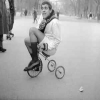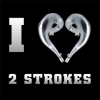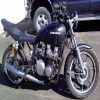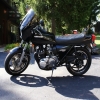rear master cylinder is pissin me off
- newOld_kz1000
-
 Topic Author
Topic Author
- Offline
- User
- FlimFlamFlibbityFlee !! BoonFryedShickaMuhZee !!
- Posts: 751
- Thanks: 20
rear master cylinder is pissin me off
26 Oct 2010 20:29
I completely disassembled and cleaned the rear master cylinder for my 1978 kz1000 A2 model. It's the original rear brake master cylinder. The parts diagram is below.
Here's the symptom:
- I put brake fluid in the cup and close the lid
- I pump the plunger
- no fluid comes out of the port on the master cylinder where the brake line connects (this port is to the left of the washer, item #5 in the diagram - the port looks like a threaded hole, which it is, but is has a hole in it to accept brake fluid pushed by the piston)
So I....
- removed the big kinda flat hex bolt on the side that exposes the channel where the brake fluid flows from the cup to the piston chamber (item #6 in the parts diagram)
- no problem, the channel fills up fine with brake fluid
So I...
- disassembled it completely again. Since brake fluid is appearing in the channel behind the hex bolt item #6, the fluid flowing from the cup is not getting into the piston chamber (I guess?)
- I used high-pressure air and blew out what appear to be 2 passages (2 small holes) just behind the hex bolt item #6 (I stuck my air gun in the hole where bolt #6 screws into)
- and I felt air come out of the piston chamber (it was disassembled, no piston was in there, I felt/heard the air pressure) -- the piston chamber is where items #7, 8 and 9 slide into
- then I blew air into the empty piston chamber and felt air come out of the hole for hex bolt item #6
THERE, DONE. Now that I've 100% cleared the hole that lets fluid flow from the chamber of hex bolt item #6 into the piston chamber -- it's fine now.
SO I...
- reassembled everything
- before adding brake fluid to the cup reservoir, I put my finger over the hole where the brake hose is normally connected and pumped the piston
- I felt pressure on my finger when I pumped (pushed in) the piston using a rod to simulate the brake lever mechanism
- I felt suction on my finger when I released (the spring item #7 pushes the piston outward, creating a suction, at least I FELT a suction)
SO I.....
- filled the reservoir
- removed hex bolt item #6 and verified brake fluid was filling its channel from the bowl to the orifice holes leading to the piston. CHECK, the fluid is there.
THEN I......
- pumped the piston, expecting brake fluid to come out of the hole where the brake hose hooks up to.
NOTHING.
THEN I....
- put my finger over the hole where brake fluid SHOULD be coming out.
- I felt pressure on my finger when I pumped (pushed in) the piston using a rod to simulate the brake lever mechanism
- I felt suction on my finger when I released
So in my mind, something in the piston chamber MUST somehow blocking the orifice that allows brake fluid to enter from the channel that sits behind the hex bolt #6.
ANYONE HAVE A WEIRD PROBLEM LIKE THIS?
It SHOULD be working! After all I feel suction/pressure/suction when I pump the piston.
Here's the symptom:
- I put brake fluid in the cup and close the lid
- I pump the plunger
- no fluid comes out of the port on the master cylinder where the brake line connects (this port is to the left of the washer, item #5 in the diagram - the port looks like a threaded hole, which it is, but is has a hole in it to accept brake fluid pushed by the piston)
So I....
- removed the big kinda flat hex bolt on the side that exposes the channel where the brake fluid flows from the cup to the piston chamber (item #6 in the parts diagram)
- no problem, the channel fills up fine with brake fluid
So I...
- disassembled it completely again. Since brake fluid is appearing in the channel behind the hex bolt item #6, the fluid flowing from the cup is not getting into the piston chamber (I guess?)
- I used high-pressure air and blew out what appear to be 2 passages (2 small holes) just behind the hex bolt item #6 (I stuck my air gun in the hole where bolt #6 screws into)
- and I felt air come out of the piston chamber (it was disassembled, no piston was in there, I felt/heard the air pressure) -- the piston chamber is where items #7, 8 and 9 slide into
- then I blew air into the empty piston chamber and felt air come out of the hole for hex bolt item #6
THERE, DONE. Now that I've 100% cleared the hole that lets fluid flow from the chamber of hex bolt item #6 into the piston chamber -- it's fine now.
SO I...
- reassembled everything
- before adding brake fluid to the cup reservoir, I put my finger over the hole where the brake hose is normally connected and pumped the piston
- I felt pressure on my finger when I pumped (pushed in) the piston using a rod to simulate the brake lever mechanism
- I felt suction on my finger when I released (the spring item #7 pushes the piston outward, creating a suction, at least I FELT a suction)
SO I.....
- filled the reservoir
- removed hex bolt item #6 and verified brake fluid was filling its channel from the bowl to the orifice holes leading to the piston. CHECK, the fluid is there.
THEN I......
- pumped the piston, expecting brake fluid to come out of the hole where the brake hose hooks up to.
NOTHING.
THEN I....
- put my finger over the hole where brake fluid SHOULD be coming out.
- I felt pressure on my finger when I pumped (pushed in) the piston using a rod to simulate the brake lever mechanism
- I felt suction on my finger when I released
So in my mind, something in the piston chamber MUST somehow blocking the orifice that allows brake fluid to enter from the channel that sits behind the hex bolt #6.
ANYONE HAVE A WEIRD PROBLEM LIKE THIS?
It SHOULD be working! After all I feel suction/pressure/suction when I pump the piston.
1978 kz1000 A2 with Kerker
1980 Z1 Classic with Kerker
1980 Z1 Classic with Kerker
Please Log in or Create an account to join the conversation.
- newOld_kz1000
-
 Topic Author
Topic Author
- Offline
- User
- FlimFlamFlibbityFlee !! BoonFryedShickaMuhZee !!
- Posts: 751
- Thanks: 20
Re: rear master cylinder is pissin me off
26 Oct 2010 21:38 - 26 Oct 2010 21:40
Here's something just occurred to me.
When you have an outdoor well for water (old farmhouse, old cabin in the mountains, whatever) you have to 'prime' the pump to get water to start flowing.
Do I need to drop some brake fluid down into the threaded hole where the brake hose connects, to 'prime' the brake piston to get it to start sucking brake fluid into it? For some 'fluid dynamics' reason I have no clue about?
I assembled it dry. The piston is moving, I'm getting suction/pressure/suction/pressure as I pump the piston, do I need to prime it with brake fluid? Before fluid will begin to flow?
When you have an outdoor well for water (old farmhouse, old cabin in the mountains, whatever) you have to 'prime' the pump to get water to start flowing.
Do I need to drop some brake fluid down into the threaded hole where the brake hose connects, to 'prime' the brake piston to get it to start sucking brake fluid into it? For some 'fluid dynamics' reason I have no clue about?
I assembled it dry. The piston is moving, I'm getting suction/pressure/suction/pressure as I pump the piston, do I need to prime it with brake fluid? Before fluid will begin to flow?
1978 kz1000 A2 with Kerker
1980 Z1 Classic with Kerker
1980 Z1 Classic with Kerker
Last edit: 26 Oct 2010 21:40 by newOld_kz1000.
Please Log in or Create an account to join the conversation.
- JMKZHI
-

- Offline
- Platinum Member
- Posts: 2429
- Thanks: 48
Re: rear master cylinder is pissin me off
27 Oct 2010 07:47 - 27 Oct 2010 07:53
Not trying to be a wise guy, but do you know how to bleed brakes? That is, are you following a standard procedure for doing the job?
Typically, you're supposed to connect tubing to the bleeder nipple on the caliper, loop the tubing higher than the nipple, & submerse the other end of the tubing into fresh brake fluid. Then add fluid to the reservoir & reinstall the cap, slowly apply the pedal several times, press down on the pedal & hold it there, open the nipple while continuing to apply pedal pressure, then close the nipple & release the pedal. etc. Or something like that.
Typically, you're supposed to connect tubing to the bleeder nipple on the caliper, loop the tubing higher than the nipple, & submerse the other end of the tubing into fresh brake fluid. Then add fluid to the reservoir & reinstall the cap, slowly apply the pedal several times, press down on the pedal & hold it there, open the nipple while continuing to apply pedal pressure, then close the nipple & release the pedal. etc. Or something like that.
Last edit: 27 Oct 2010 07:53 by JMKZHI.
Please Log in or Create an account to join the conversation.
- Kidkawie
-

- Offline
- User
- I bleed premix
- Posts: 1913
- Thanks: 243
Re: rear master cylinder is pissin me off
27 Oct 2010 08:09
You can use your finger too, but it makes a mess.
With your finger over the port, actuate the m/c and let fluid/air bypass your finger, then when you release the plunger put pressure back to the port.
This method kind of siphens fluid through.
With your finger over the port, actuate the m/c and let fluid/air bypass your finger, then when you release the plunger put pressure back to the port.
This method kind of siphens fluid through.
1975 Z1 900
1994 KX250 Supermoto
2004 KX125
1994 KX250 Supermoto
2004 KX125
Please Log in or Create an account to join the conversation.
- Becker
-

- Offline
- User
- The Doctor Will Rise Again
- Posts: 386
- Thanks: 1
Re: rear master cylinder is pissin me off
27 Oct 2010 08:46
I think you have to fully assemble the brake system before it'll really work. If you've cleaned the MC completely then you shouldn't have anything to worry about. put it all back together, bleed it and I bet it'll work. Master cylinders are funny that way. Just make sure to use new washers when you put all the pieces together. I've spent hours trying to bleed brakes when there is just a little bit of air leaking past a washer.
78 KZ750B3
79 KZ400 LTD
78 KZ650C2
79 KZ650C3
78 KZ650B2A
80 KZ650F1
80 KZ650E1
81 CB750K Super Sport
79 KZ400 LTD
78 KZ650C2
79 KZ650C3
78 KZ650B2A
80 KZ650F1
80 KZ650E1
81 CB750K Super Sport
Please Log in or Create an account to join the conversation.
- Patton
-

- Offline
- KZr Legend
- Posts: 18640
- Thanks: 2100
Re: rear master cylinder is pissin me off
27 Oct 2010 09:03
newOld_kz1000 wrote:
There are two holes through bottom of reservoir.
The holes are sometimes referred to as ports or orifices.
The larger hole supplies brake fluid to the bore.
The smaller hole is a relief port to relax line pressure when the brake is released.
Am guessing one of the two holes at bottom of reservoir is blocked, and suspecting it's the smaller relief port.
Could be wrong, but thinking there should not be "suction" felt where fluid exits from the master cylinder.
Anyhow, here's what the FSM provides.
There are 4 pages, so here goes:
Good Fortune!
[Click on this image or images in the following posts to enlarge the views.]
...1978 kz1000 A2...original rear brake master cylinder...filled the reservoir...put my finger over the hole where brake fluid SHOULD be coming out...felt pressure on my finger when I pumped (pushed in) the piston using a rod to simulate the brake lever mechanism...felt suction on my finger when I released... feel suction/pressure/suction when I pump the piston.
There are two holes through bottom of reservoir.
The holes are sometimes referred to as ports or orifices.
The larger hole supplies brake fluid to the bore.
The smaller hole is a relief port to relax line pressure when the brake is released.
Am guessing one of the two holes at bottom of reservoir is blocked, and suspecting it's the smaller relief port.
Could be wrong, but thinking there should not be "suction" felt where fluid exits from the master cylinder.
Anyhow, here's what the FSM provides.
There are 4 pages, so here goes:
Good Fortune!
[Click on this image or images in the following posts to enlarge the views.]
1973 Z1
KZ900 LTD
KZ900 LTD
Attachments:
Please Log in or Create an account to join the conversation.
- Patton
-

- Offline
- KZr Legend
- Posts: 18640
- Thanks: 2100
- Patton
-

- Offline
- KZr Legend
- Posts: 18640
- Thanks: 2100
Re: rear master cylinder is pissin me off
27 Oct 2010 09:05 - 27 Oct 2010 09:07
1973 Z1
KZ900 LTD
KZ900 LTD
Attachments:
Last edit: 27 Oct 2010 09:07 by Patton.
Please Log in or Create an account to join the conversation.
- Patton
-

- Offline
- KZr Legend
- Posts: 18640
- Thanks: 2100
- newOld_kz1000
-
 Topic Author
Topic Author
- Offline
- User
- FlimFlamFlibbityFlee !! BoonFryedShickaMuhZee !!
- Posts: 751
- Thanks: 20
Re: rear master cylinder is pissin me off
27 Oct 2010 09:25 - 27 Oct 2010 09:26
JMKZHI wrote:
Yep have bled many times. Before disassembling/cleaning the master cylinder I was doing the brake bleed and getting nowhere so I disconnected the brake hose at the caliper end and it was dry.
Right then I knew the m/c was not providing fluid through the hose. I then disconnected the hose at the m/c end and again found it dry. THEN and only then did I pull the m/c out for a cleaning.
Not always do I do it, but I try to remember to do the *easy* stuff first (step (1) bleed the brakes, step (2) disconnect the hose at the caliper end and check for fluid).
I always try doing the *easy* stuff first long before the hard stuff. So yep I pretty much knew before pulling/cleaning the m/c that it was needed.
Not trying to be a wise guy, but do you know how to bleed brakes? That is, are you following a standard procedure for doing the job?
Typically, you're supposed to connect tubing to the bleeder nipple on the caliper, loop the tubing higher than the nipple, & submerse the other end of the tubing into fresh brake fluid. Then add fluid to the reservoir & reinstall the cap, slowly apply the pedal several times, press down on the pedal & hold it there, open the nipple while continuing to apply pedal pressure, then close the nipple & release the pedal. etc. Or something like that.
Yep have bled many times. Before disassembling/cleaning the master cylinder I was doing the brake bleed and getting nowhere so I disconnected the brake hose at the caliper end and it was dry.
Right then I knew the m/c was not providing fluid through the hose. I then disconnected the hose at the m/c end and again found it dry. THEN and only then did I pull the m/c out for a cleaning.
Not always do I do it, but I try to remember to do the *easy* stuff first (step (1) bleed the brakes, step (2) disconnect the hose at the caliper end and check for fluid).
I always try doing the *easy* stuff first long before the hard stuff. So yep I pretty much knew before pulling/cleaning the m/c that it was needed.
1978 kz1000 A2 with Kerker
1980 Z1 Classic with Kerker
1980 Z1 Classic with Kerker
Last edit: 27 Oct 2010 09:26 by newOld_kz1000.
Please Log in or Create an account to join the conversation.
- newOld_kz1000
-
 Topic Author
Topic Author
- Offline
- User
- FlimFlamFlibbityFlee !! BoonFryedShickaMuhZee !!
- Posts: 751
- Thanks: 20
Re: rear master cylinder is pissin me off
27 Oct 2010 11:03
Patton wrote:
Yep I think you're right. Let me clarify for others what the problem of this suction is.
I put my finger on the outlet hole on the m/c (master cylinder) where the brake hose usually connects.
With the m/c in my hand I use a rod from the outside to push in on the piston, simulating what the rear brake pedal does when you step on the brake.
When I push the m/c piston to simulate stepping on the brake -- I feel pressure coming from the m/c outlet, which is GOOD as it means that fluid will come out and then through the brake hose to the caliper, once I figure out what's blocking the fluid.
The BAD part here is the suction I feel.
After pushing in the piston as above, I release the piston, as if I took my foot off the brake.
And then I feel suction on my finger at the outlet port.
Well, that suction is just the m/c piston returning to the 'rest' position.
BUT THE MASTER CYLINDER IS FULL OF FLUID when I do that. And NO FLUID is being sucked into the piston area.
So I'm feeling the correct suction being caused by relaxing the piston but no fluid coming down from the reservoir. Something is restricting the flow out of the fluid reservoir.
Ever try to drain a bike's gas tank when the fuel cap vent is clogged? If the fuel cap vent on a bike is clogged, it reduces gas flowing out of the gas tank into the carbs. You can cause a bike to stall out if you completely shut the air vent in the cap.
If you want to drain the gas FAST you then remove the gas cap.
Patton's referring to the same principle here I reckon. There is a blocked hole in the m/c that is preventing correct flow from the master cylinder tank.
I'll have to figure out how to unblock that.
By the way, I had this m/c torn apart completely and used high pressure air and STILL I have a clogged port.
What is a 'safe' cleaning solvent to pour into the master cylinder cap?
There are two holes through bottom of reservoir.
The holes are sometimes referred to as ports or orifices.
The larger hole supplies brake fluid to the bore.
The smaller hole is a relief port to relax line pressure when the brake is released.
Am guessing one of the two holes at bottom of reservoir is blocked, and suspecting it's the smaller relief port.
Could be wrong, but thinking there should not be "suction" felt where fluid exits from the master cylinder.
Anyhow, here's what the FSM provides.
There are 4 pages, so here goes:
Good Fortune!
Yep I think you're right. Let me clarify for others what the problem of this suction is.
I put my finger on the outlet hole on the m/c (master cylinder) where the brake hose usually connects.
With the m/c in my hand I use a rod from the outside to push in on the piston, simulating what the rear brake pedal does when you step on the brake.
When I push the m/c piston to simulate stepping on the brake -- I feel pressure coming from the m/c outlet, which is GOOD as it means that fluid will come out and then through the brake hose to the caliper, once I figure out what's blocking the fluid.
The BAD part here is the suction I feel.
After pushing in the piston as above, I release the piston, as if I took my foot off the brake.
And then I feel suction on my finger at the outlet port.
Well, that suction is just the m/c piston returning to the 'rest' position.
BUT THE MASTER CYLINDER IS FULL OF FLUID when I do that. And NO FLUID is being sucked into the piston area.
So I'm feeling the correct suction being caused by relaxing the piston but no fluid coming down from the reservoir. Something is restricting the flow out of the fluid reservoir.
Ever try to drain a bike's gas tank when the fuel cap vent is clogged? If the fuel cap vent on a bike is clogged, it reduces gas flowing out of the gas tank into the carbs. You can cause a bike to stall out if you completely shut the air vent in the cap.
If you want to drain the gas FAST you then remove the gas cap.
Patton's referring to the same principle here I reckon. There is a blocked hole in the m/c that is preventing correct flow from the master cylinder tank.
I'll have to figure out how to unblock that.
By the way, I had this m/c torn apart completely and used high pressure air and STILL I have a clogged port.
What is a 'safe' cleaning solvent to pour into the master cylinder cap?
1978 kz1000 A2 with Kerker
1980 Z1 Classic with Kerker
1980 Z1 Classic with Kerker
Please Log in or Create an account to join the conversation.
- JakeB
-

- Offline
- User
- Posts: 174
- Thanks: 0
Re: rear master cylinder is pissin me off
27 Oct 2010 11:38
You are right about needing to "prime the pump." Like kidkawie said you can do this with your finger while the brake lines are disconnected.
Push in the piston (like brakes are being applied) with your finger off of the brake line port. Then before you let the piston back out seal the port with your finger. Don't remove your finger from the port until the piston is all the way out. Then remove your finger and push the piston in again. Seal port, let piston out, unseal port, push piston in, etc.
Do this several times and brake fluid should be drawn through the master cylinder by the vacuum you were feeling.
As I understand it, the small return port in the bottom of the reservoir allows fluid to return to the master cylinder after the brakes are released. That being clogged should have no effect on fluid flowing out of the master cylinder, only on fluid flowing back in.
If the master cylinder didn't allow the brake fluid to flow back into it (clogged return port), then the brake pads would never "release" from the disk. They would just try to keep squeezing harder and harder every time you used the brakes.
Push in the piston (like brakes are being applied) with your finger off of the brake line port. Then before you let the piston back out seal the port with your finger. Don't remove your finger from the port until the piston is all the way out. Then remove your finger and push the piston in again. Seal port, let piston out, unseal port, push piston in, etc.
Do this several times and brake fluid should be drawn through the master cylinder by the vacuum you were feeling.
As I understand it, the small return port in the bottom of the reservoir allows fluid to return to the master cylinder after the brakes are released. That being clogged should have no effect on fluid flowing out of the master cylinder, only on fluid flowing back in.
If the master cylinder didn't allow the brake fluid to flow back into it (clogged return port), then the brake pads would never "release" from the disk. They would just try to keep squeezing harder and harder every time you used the brakes.
1978 Z1-R
Please Log in or Create an account to join the conversation.





